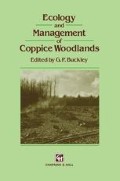Abstract
Coppicing has been practised since medieval times to produce small round-wood for fencing, fuel, etc. (Chapter 2). More recently coppice management has been valued for its conservation benefits in terms of both generally increasing structural diversity of woodlands and species diversity, and supporting specific species groups, such as butterflies (Chapter 13) and birds (Chapter 9).
Access this chapter
Tax calculation will be finalised at checkout
Purchases are for personal use only
Preview
Unable to display preview. Download preview PDF.
References
Cibien, C. and Sempere, A. (1989) Food availability as a factor in habitat use by roe deer. Acta Theriol. 34,111–24.
Cook, J.L. (1969) Conservation by bulldozer. Michigan Academician 1, 179–91.
Dunin, V.F. (1985) Improving the food resource for deer. Lesnoe Khozyaistvo 4, 58–60.
Hill, D. and Robertson, P. (1988) The Pheasant: Ecology management and conservation Blackwell, Oxford.
Hill, M.O. (1979) The development of a flora in even-aged plantations, in Ecology of Even-aged Forest Plantations (eds E.D. Ford, D.C. Malcolm and J. Atterson), Institute of Terrestrial Ecology, Cambridge, 175–192.
Hofmann, R.R. (1985) Digestive physiology of the deer -their morphophysiological specialization and adaptation, in Biology of Deer Production (eds P.F. Fennessy and K.R. Drew), Proceedings of the Royal Society of New Zealand, Dunedin, 393–407.
How, R.C. (1986) An investigation into the vegetational differences between an ungrazed and grazed areas of enclosed woodland in the New Forest BSc thesis, University of Southampton.
Konig, E. and Gossow, H. (1979) Even-aged plantations as a habitat for deer in Central Europe, in Ecology of Even-aged Forest Plantations (eds E.D. Ford, D.C. Malcolm and J. Atterson), Institute of Terrestrial Ecology, Cambridge, 429–52.
Lozovoi, A.D. and Sukhoroslov, M.S. (1976) Classifying hunting areas by quality on the basis of the total phytomass of the stands. Lesnoe Khozyaistvo 6, 72–5.
McCabe, S.M. and Barry, T.N. (1988) Nutritive value of willow Salix spp., for sheep, goats and deer. Journal of Agricultural Science 111, 1–10.
Mann, J.C.E. (1978) An investigation into the vegetational differences between an ungrazed and a grazed portion of the New Forest with special emphasis on the species composition species diversity and productivity of the areas. BSc thesis, University of Southampton.
Martinot-Lagarde, P. (1975) The management of coppice kept for game. Bulletin Technique Office National des Forêts 7, 41–4.
Mattson, W.J. (1980) Herbivory in relation to plant nitrogen content. A review. Annual Review of Ecology and Systematics 11, 119–62.
Mitchell, B., Staines, B.W. and Welch, D.W. (1977) Ecology of red deer. A research review relevant to their management in Scotland Institute of Terrestrial Ecology, Cambridge.
Pepper, H.W. (1978) Chemical repellents Forestry Commission Leaflet, 73, HMSO, London.
Pepper, H.W., Rowe, J.J. and Tee, L.A. (1985) Individual tree protection Forestry Commission Arboricultural Leaflet, 10, HMSO, London.
Pepper, H.W. and Tee, L.A. (1986) Forest fencing Forestry Commission Leaflet, 87, HMSO, London.
Peterken, G.F. (1981) Woodland Conservation and Management Chapman and Hall, London.
Peterken, G.F. and Jones, E.W. (1989) Forty years of change in Lady Park Wood, UK. The young growth stands. Journal of Ecology 77, 401–29.
Peterken, G.F. and Tubbs, C.R. (1965) Woodland regeneration in the New Forest, Hampshire since 1650. Journal of Applied Ecology 2, 159–70.
Picard, J.F. (1976) Feeding preferences of deer and their consequences: first conclusions from two years experimentation. Revue Forestière Française 28, 106–14.
Prior, R. (1983) Trees and Deer Batsford, London.
Putman, R.J. (1986) Grazing in Temperate Ecosystems: Large herbivores and the ecology of the New Forest Croom Helm, London.
Putman, R.J. (1988) The Natural History of Deer Christopher Helm, London.
Putman, R.J., Edwards, P.J., Mann, J.C.E. et al. (1989) Vegetational and faunal changes in an area of heavily grazed woodland following relief of grazing. Biological Conservation 47, 13–32.
Rackham, O. (1975) Hayley Wood: its history and natural history Cambridgeshire and Isle of Ely Naturalists’ Trust, Cambridge.
Ratcliffe, P.R. (1988) The management of red deer populations resident in upland forests, in Wildlife Management in Forests (Ed. D. Jardine), Institute of Chartered Foresters, Edinburgh.
Ratcliffe, P.R. and Pepper, H.W. (1987) The impact of roe deer, rabbits and grey squirrels on the management of broadleaved woodlands, in Proceedings of the National Hardwoods Programme, Oxford Forestry Institute Occasional Paper, 34, Department of Plant Sciences, University of Oxford, pp. 39–50.
Rhoades, D.F. and Gates, R.G. (1976) Toward a general theory of plant anti-herbivore chemistry. Recent Advances in Phytochemistry 10, 166–213.
Sackur, V. (1984) A study of the patterns of habitat use by fallow deer (Dama dama) in south-west Suffolk (with particular reference to coppiced woodlands BSc thesis, University of Southampton.
Shipman, R.D. (1972) Stump sprouting studied for timber, deer browse. Science in Agriculture 19, 3–4.
Smale, M.C. (1982) Vegetative regrowth of Beilschmiledia tawa after selective logging at Pureora and Rotoehu. New Zealand Journal of Forest Science 12, 442–7.
Editor information
Editors and Affiliations
Rights and permissions
Copyright information
© 1992 Springer Science+Business Media Dordrecht
About this chapter
Cite this chapter
Ratcliffe, P.R. (1992). The interaction of deer and vegetation in coppice woods. In: Buckley, G.P. (eds) Ecology and Management of Coppice Woodlands. Springer, Dordrecht. https://doi.org/10.1007/978-94-011-2362-4_12
Download citation
DOI: https://doi.org/10.1007/978-94-011-2362-4_12
Publisher Name: Springer, Dordrecht
Print ISBN: 978-94-010-5042-5
Online ISBN: 978-94-011-2362-4
eBook Packages: Springer Book Archive

